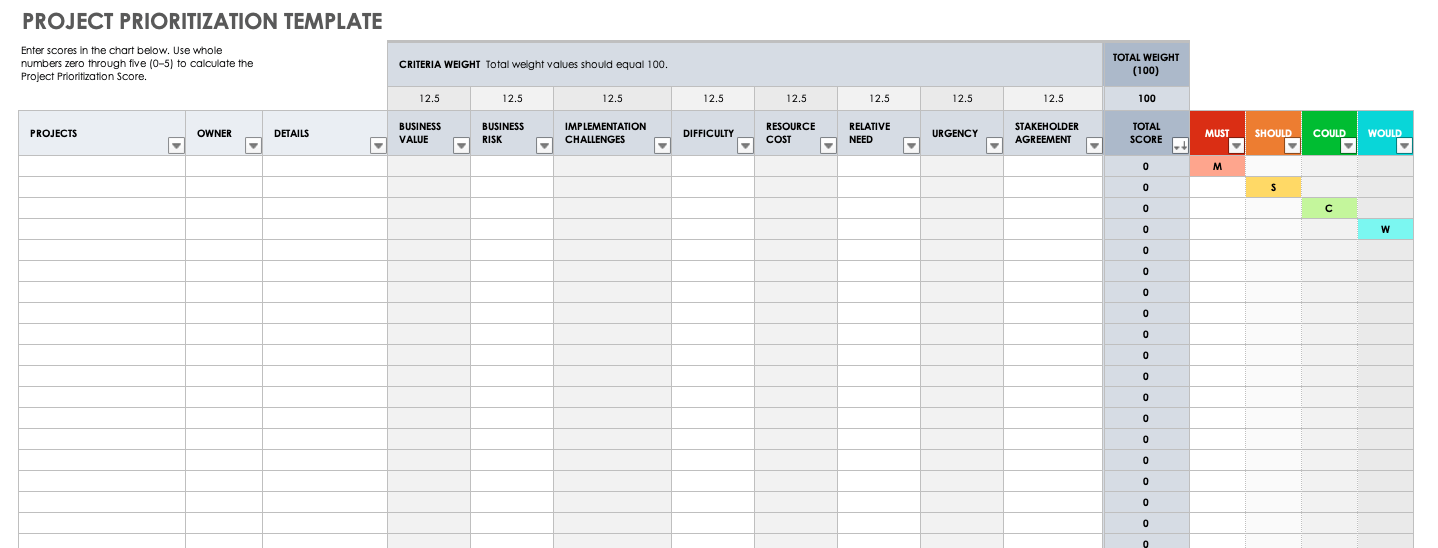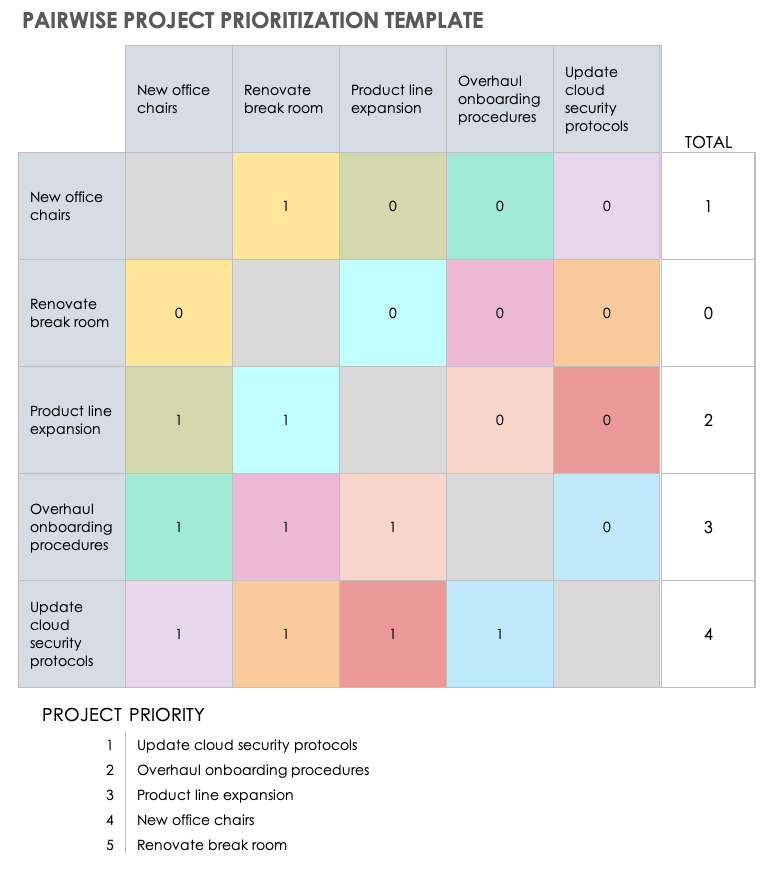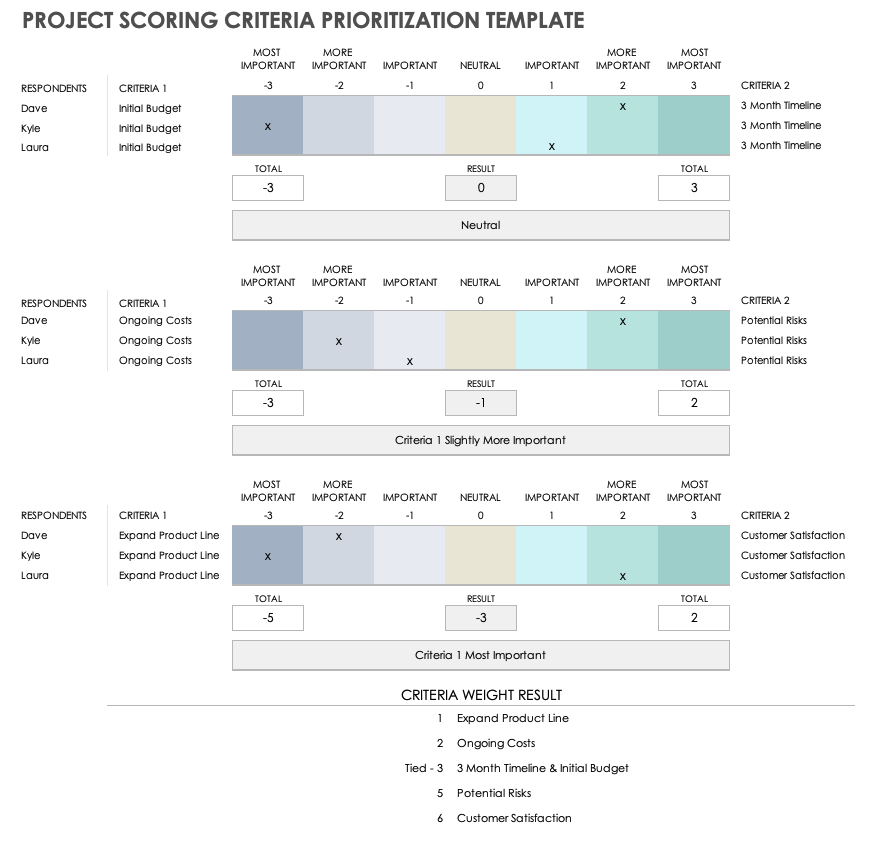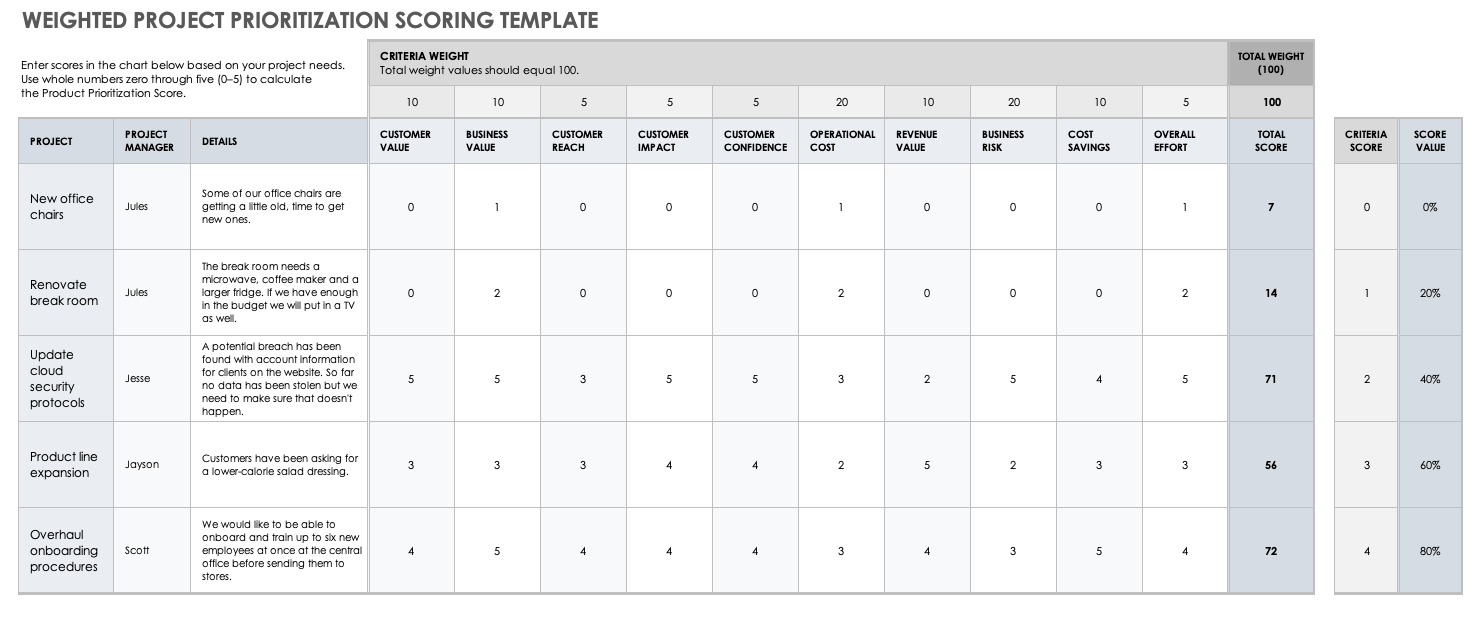What Is Priority in Project Management?
In project management, priority refers to the urgency and importance of a task or project. Project managers use priority to determine who will take ownership of each task and when to expect results.
There are many factors that determine priority, including time and money spent, available and needed resources, and company-specific needs. Project and program managers must weigh these factors against one another to determine which project is the highest priority.
Project Management Guide
Your one-stop shop for everything project management

Ready to get more out of your project management efforts? Visit our comprehensive project management guide for tips, best practices, and free resources to manage your work more effectively.
What Is Project Prioritization?
Project prioritization is the process of determining which potential and existing projects are the most urgent and important. This process involves evaluating the criteria that are most relevant to your business and applying them to all of your projects.
You may rank project priority based on potential return on investment (ROI) or on how critical each project is to a department. For example, projects related to production infrastructure or web-based security might rank highly. All companies have different needs that require unique prioritization strategies.
Many organizations struggle with prioritization because all projects have some degree of urgency and importance. The best strategy is to establish a strategic planning framework so that you can easily incorporate the company’s goals and priorities into your prioritization process.
Why Is Project Prioritization Important?
Project prioritization ensures that you correctly allocate company resources based on your unique needs. By prioritizing tasks, a company can minimize the time and money it spends on less urgent and important projects.
A 2016 survey by the Project Management Institute found that only 52 percent of projects met the original goals and business intent when project management culture was low priority. However, that number increased by almost 20 percent when companies prioritized project management culture. Project management and project prioritization are crucial to a project’s success.
How To Prioritize Your Projects
A project prioritization process is essential for keeping criteria consistent across a portfolio and for addressing the specific needs and goals of an organization. Here are the basic steps of prioritizing a list of projects:
- Create a List of Projects: Create a list of potential and existing projects. Consult high-ranking executives, department heads, and project leaders to ensure that you accurately assess the company’s project needs.
- Organize Projects by Obvious Priority Level: In some cases, project priority will be obvious. “Prioritizing your projects involves making a list of individual projects and then separating the urgent and important ones, so you know what you have to focus on immediately,” suggests Trevor Larson, Co-Founder and CEO of Nectar.
- Determine Prioritization Criteria: When priority levels of projects are not immediately obvious, determine prioritization criteria based on your company’s specific needs and goals.
- Analyze and Rank Tasks: Apply these prioritization criteria to your projects to determine the urgency and importance of each and to rank them accordingly.
You may consider using a matrix or template to help with your prioritization efforts. Prioritization templates are useful tools to aid in your decision-making and help track your prioritization process. There are also specific details regarding IT project prioritization, which may be helpful if you're trying to prioritize projects for IT-focused teams.
Project Prioritization Template
Download Project Prioritization Template
Microsoft Excel | Google Sheets
Use this project prioritization template to rank projects based on the pre-filled criteria, or input criteria specific to your organization. Input a value from one to five in each cell to indicate the importance of each variable, and the template will automatically calculate a score for each project on your list.
Priority Levels for Projects
You can classify projects as high, middle, low, or no importance. Another way to think of these levels is “do, delegate, schedule, and delete.” The prioritization criteria and framework that you choose will determine the priority level of each project.
To gain a greater understanding of how to determine priority levels, read our guide to using priority matrices.
Project Prioritization Process
Project prioritization processes help create frameworks to rank projects based on a consistent set of variables. Here is a list of specific techniques and processes for determining project prioritization:
- Kano: The Kano model suggests that the features available in a final product determine a customer’s satisfaction with that project. Identify the features that will provide a high level of satisfaction to the end user and prioritize those projects.
- Payback Period: The payback period is the time it takes to recoup the cost of an investment. When calculating the payback period, note both ongoing costs and income potential. While a project with a shorter payback period may be preferable, you should also consider the project’s duration and its potential for ongoing returns. This is a straightforward method that focuses on cash flow and does not account for potential risks or hurdles.
- Net Present Value: Net present value compares the current cost of a project to the ROI. Net present value takes the potential for discounted cash flow into account but leaves out many non-financial variables.
- Scoring Model: Scoring models assign a numerical value to projects based on criteria predetermined by decision-makers. Higher scores correspond to higher-priority projects.
- Story Mapping: Story mapping is the process of creating a hypothetical map of the user’s experience with a product. The map helps highlight the features of a product that a user is most likely to interact with and which are therefore most important. To learn more, check out our list of downloadable user story templates.
- MoSCoW Method: MoSCoW is an acronym that stands for “Must have, Should have, Could have, Won’t have.” The MoSCoW method is a priority matrix that quickly sorts options into four prioritization categories. This is a variation on the traditional four-square priority matrix, which sorts projects by urgency and importance.
“MoSCoW is a management acronym that is commonly used in industries such as project management and software development, but that can also be applied to everyday priorities. We outline the MoSCoW approach as part of every project,” says Ansh Gupta, Founder of Empire Crafter. - Analytic Hierarchy Process: The analytic hierarchy process determines project priority through a series of pairwise comparisons among projects. Create a numerical score for each project using the criteria that is most relevant to your company’s needs. Higher scores correlate to higher priority projects.
- Data Envelopment Analysis: Data envelopment analysis measures the relative efficiency of similar organizational units. Project managers can use this method to identify units that are more productive, so they can prioritize projects accordingly.
- Priority Matrix: A priority matrix is a straightforward tool that helps determine the most crucial projects on a list. A priority matrix can be as simple as a two-by-two square that measures urgency and importance. It can also be a larger grid that compares many variables.
- Risk Priority Matrix: Alex Claro, VPN Analyst at CreditDonkey, shares his method of using a modified priority matrix to prioritize risk levels: “To begin, develop a list of your risks, including the worst-case scenarios. After you've compiled your list, you'll need to figure out which ones are most likely to cause problems. At this stage, you should consider how to avoid those high-impact risk occurrences from occurring. These are your primary concerns. This helps you to identify which risks are likely to have the most serious effects, and then take steps to mitigate those risks.”
Benefits of Project Prioritization
There are many benefits to prioritizing projects. Your team will spend their time more efficiently, stay more organized, and increase the success rate of their projects. Here is a list of benefits that experts have noted from implementing project prioritization strategies:
- Increased Efficiency: Lester Mclaughlin, VP of Operations at Blue National, shares his company’s experience with improved prioritization: “We’ve certainly seen an improvement to our workflow. Given the overwhelming amount of demand for our services, we don’t have time to waste on avoidable inefficiencies,” he says.
- Improved Organization: Prioritization processes organize projects and tasks into a hierarchy that is easier to manage. “I like to use an Eisenhower matrix that categorizes projects as important or not important and urgent or not urgent. Based on what square of the matrix a project falls into, the task becomes something I must do immediately, something I must decide on when to tackle, something that I can delegate to a direct report, or something I can remove from my list altogether,” says Larson.
- Increased Success Rate: Standardized prioritization practices ensure that projects adhere to company goals and needs.
- Increased Team Cohesion:
Project prioritization decreases stress by increasing project visibility and improving communication within a team. “Prioritizing projects in our organization is essential to stress and productivity management. Employees are happier and more fulfilled when they can consistently be submitting work without the stress of what comes next,” says Michael Steele, CEO and owner of Flywheel Digital. - Improved Buy-In: Effective project prioritization builds trust in project managers over time. Executives are more likely to support projects led by employees with a track record of success.
Competing Priorities in Project Management
Competing priorities can be a barrier to success. Identifying the most important prioritization criteria for an organization can be difficult, but maintaining visibility and communication is key to avoiding unwelcome surprises.
Make sure that you involve every stakeholder in selecting your prioritization criteria. Doing so will help mitigate conflict by allowing team members with competing priorities to be heard. Once you have selected your prioritization criteria, be sure to keep them consistent throughout the company.
“With competing priorities, it makes sense to first get a second opinion from a colleague or trusted coworker to ensure you are interpreting the nature of the priorities correctly and that they are actually competing. If they are competing for importance, prioritize the one whose risk of failure increases over time, due to things like changing market conditions or manpower complications because of holidays or seasonal downturns,” suggests Larson.
Additionally, Steele suggests that companies use project management software to help track tasks and stay organized. “[PM software] helps everyone feel like the work they’re doing is far more manageable, even with competing priorities,” he says. “It can be hard to prioritize the internal tasks over those that contribute directly to ROI. Still, we prioritize them based on estimated value to our team, which holds an important value for us as a company, even if it is not directly reflected in the bottom line.”
When to Prioritize Projects
Prioritizing projects should be a regular part of a project manager’s schedule. Needs change over the course of a venture, so it is important to assess how current and potential projects rank in the portfolio at all times.
If a project manager notices a lack of project visibility, process inconsistencies, or a breakdown in collaboration, then it is likely time to reevaluate priorities. These issues may have various causes, but they point to a problem with unclear or obsolete priority criteria.
Pairwise Project Prioritization Template
Download Pairwise Project Prioritization Template
Microsoft Excel | Google Sheets
Use this template to quickly organize projects by relative importance. Enter projects into the grid and determine which is more important in each pairwise comparison. The resulting numerical score for each project will create a hierarchy without the need for you to identify prioritization criteria.
Project Scoring Criteria Prioritization Template
Download Project Scoring Criteria Prioritization Template
Microsoft Excel | Google Sheets
Use this project scoring criteria template to determine the most important criteria for prioritization matrices in your company. Consult key decision-makers and record and compare their responses to identify the most important criteria across departments. Enter the results into the prioritization template above to create a standardized framework for company-wide use.
Weighted Project Prioritization Scoring Template
Download Weighted Project Prioritization Scoring Template
Microsoft Excel | Google Sheets
For more complicated comparisons, use this weighted project prioritization scoring template. Input the prioritization criteria you gathered from key decision-makers into the template, choose their weights, and score them for each project. You can then rank the importance of various criteria based on their resulting numerical score.
Project Prioritization Facilitation Kit
Download Project Prioritization Facilitation Kit
Find helpful templates in our project prioritization facilitation kit. The kit includes the project prioritization template, the weighted project prioritization scoring template, the project scoring criteria prioritization template, and the pairwise prioritization template listed above. A portfolio of properly prioritized projects will aid in your project portfolio management or project selection endeavors.
Get the Most out of Project Prioritization with Smartsheet for Project Management
From simple task management and project planning to complex resource and portfolio management, Smartsheet helps you improve collaboration and increase work velocity -- empowering you to get more done. The Smartsheet platform makes it easy to plan, capture, manage, and report on work from anywhere, helping your team be more effective and get more done. Report on key metrics and get real-time visibility into work as it happens with roll-up reports, dashboards, and automated workflows built to keep your team connected and informed. When teams have clarity into the work getting done, there’s no telling how much more they can accomplish in the same amount of time. Try Smartsheet for free, today.






